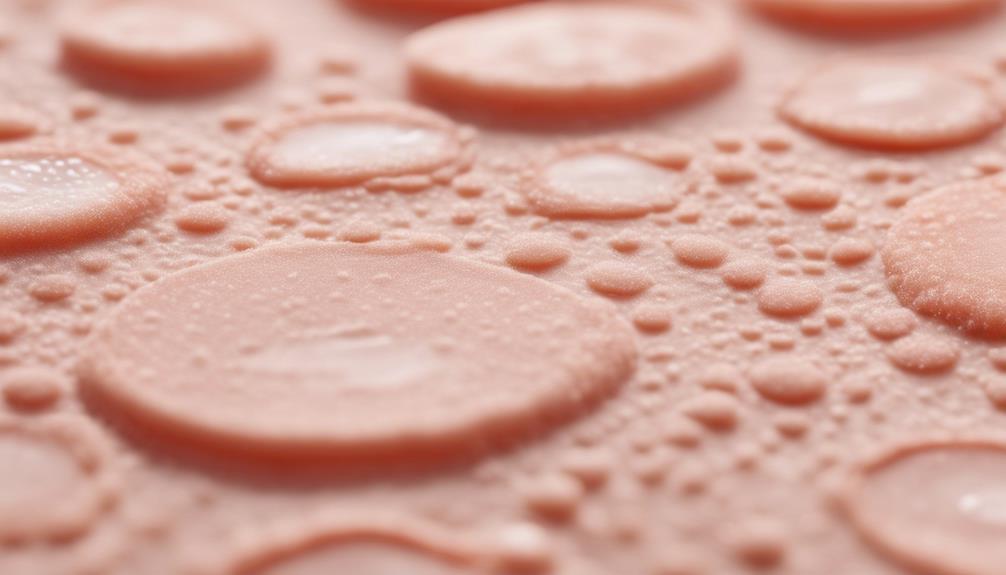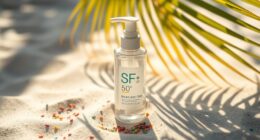You can’t apply skincare products over a pimple patch. Doing so can ruin its adhesion and effectiveness. Make sure your skin is clean and dry before placing the patch on the affected area. Oil-based products are a no-go, as they can compromise the patch’s grip. Avoid makeup too; it can also hinder the patch’s performance. Stick to these do’s and don’ts for the best results, and you’ll discover even more tips to optimize your pimple patch experience.
Key Takeaways
- Do apply pimple patches on clean, dry skin as the first step in your skincare routine.
- Do not use oil-based products before applying patches to ensure proper adhesion.
- Do not apply makeup over pimple patches, as it can interfere with adhesion and effectiveness.
- Look for patches containing hydrocolloid or salicylic acid for enhanced healing benefits.
- Always ensure skin is free from excess oil for optimal patch performance.

When you’re dealing with a pimple, it’s tempting to layer your usual skincare products over the pimple patch for extra care. However, doing so can actually backfire. The first thing to remember is that pimple patches are designed to be applied directly onto clean, dry skin. This means they should be the first step in your skincare routine, not an afterthought. If you really want the patch to work effectively, you need to avoid applying anything else over it.
One major reason for this is that oil-based skincare products can hinder the patch’s adhesion. When you apply a pimple patch, you want it to stick firmly to the skin to absorb fluid and protect the pimple. If you’ve just used an oil-based product, you might find that your patch won’t adhere properly, compromising its effectiveness. To avoid this, make certain to cleanse your face thoroughly and remove any excess oil before you apply the patch. If you’ve already applied other products, a simple clean-up with a Q-tip can help you eliminate that excess oil from the area. Additionally, using patches with hydrocolloid technology can significantly enhance their effectiveness in drawing out impurities, as they create a moisture-retaining barrier that aids in healing. Maintaining skin hydration is crucial for optimal healing, so consider incorporating effective hydration techniques into your routine.
Another important point is that you should definitely avoid applying makeup over a pimple patch. While it might seem like a good idea to cover up the blemish, makeup can interfere with the patch’s adhesion and may even cause it to fall off. The last thing you want is to spend time applying the patch only to find it slipping or losing its potency because of a layer of foundation or concealer on top.
So, what’re the Do’s and Don’ts when it comes to using pimple patches?
Do apply the patch to clean, dry skin as the first step in your skincare routine.
Don’t use oil-based skincare products beforehand, and definitely avoid any makeup on top of the patch. Remember that effective pimple patches often contain salicylic acid or hydrocolloid technology, which can enhance their ability to reduce inflammation.
Following these guidelines guarantees your pimple patch maintains its adhesion and effectiveness, helping you achieve clearer skin faster.
Frequently Asked Questions
Can You Put Skincare Over Pimple Patches?
You shouldn’t put skincare over pimple patches.
Doing so can interfere with their adhesion and effectiveness. Pimple patches work best on clean, dry skin, so apply them first, before any other products.
If you need to apply skincare around the patch, use oil-free products and avoid makeup directly on it.
This way, you’ll maximize the patch’s ability to absorb pus and promote healing, ensuring you get the best results.
What Not to Do With Pimple Patches?
When using pimple patches, there are a few key things you shouldn’t do.
Don’t apply any skincare or makeup over the patch, as it can reduce its effectiveness.
Avoid oil-based products before applying, since they can hinder adhesion.
Never reuse a patch after taking it off, as it risks bacteria transfer.
Also, steer clear of placing patches on broken skin, and don’t expect instant results; they’re best for whiteheads.
Can You Use Pimple Patches With Other Products?
Did you know that nearly 70% of people experience breakouts at some point in their lives?
When you’re dealing with pimple patches, it’s best to keep it simple. You shouldn’t layer other products directly over the patch, as this can reduce its effectiveness and adhesion.
Instead, apply treatments to the surrounding skin, allowing the patch to work its magic alone. Give it 6-8 hours for ideal results, and your skin will thank you!
What to Put on Pimples After a Pimple Patch?
After you remove a pimple patch, it’s essential to treat the area properly.
Start by gently cleansing the skin to remove any residue.
Then, apply a soothing serum with ingredients like aloe vera or hyaluronic acid to calm irritation.
Don’t rush to use heavy creams or makeup; your skin needs to breathe and heal first.
Keep an eye on the area, and if needed, consider using another pimple patch for continued support.
Conclusion
So, when you’re dealing with a pimple patch, think of it as a protective shield for your skin. You can layer your skincare over it, but remember to be gentle and avoid heavy products that could disrupt its magic. Treat it with care, and let it work its wonders while you continue your routine. After all, your skin deserves the best, and a little patience can turn those pesky blemishes into distant memories!










